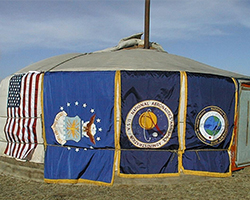Peter Brown
Peter Brown, a meteor physicist in the Department of Physics and Astronomy has been craning his neck skywards since early childhood – the only difference now is that he has a battery of fully-automated camera stations at his disposal to relieve the joint pain. “I’ve been intrigued by meteors since I was a kid. I always knew that was what I wanted to study so I did my undergrad in physics, then came to Western to do my graduate studies under James Jones in meteor physics,” says Brown. After a postdoctoral position in New Mexico, Brown came straight back to Western as a member of faculty. Having had a stable base in London, Ontario for almost all of his academic life has meant anything but complacency for Brown – his work has taken him to observational missions across the globe, from Edwards Air Force Base in California to the Canary Islands to Mongolia.
 “Mongolia was a blast because we were working with the US Air Force reporting meteor shower activity in real-time to try and protect defense satellites in space from being bombarded,” tells Brown. “Back in the late 90s when we did this, we ran out of computer memory while deep in Outer Mongolia,” he laughs, “I had to go on national Mongolian television to put out a request for any computer memory we could borrow because our window to observe the showers was too narrow to wait for a shipment from home.” Brown’s formative experiences of working with the US Air Force have blossomed into a close relationship with NASA, which continues today.
“Mongolia was a blast because we were working with the US Air Force reporting meteor shower activity in real-time to try and protect defense satellites in space from being bombarded,” tells Brown. “Back in the late 90s when we did this, we ran out of computer memory while deep in Outer Mongolia,” he laughs, “I had to go on national Mongolian television to put out a request for any computer memory we could borrow because our window to observe the showers was too narrow to wait for a shipment from home.” Brown’s formative experiences of working with the US Air Force have blossomed into a close relationship with NASA, which continues today.
Together, they produce threat assessments of how incoming meteoroids affect crucial telecommunications and defense satellites. “In a sense, I was lucky that my time as a PhD student coincided with the peak activity of the Leonids – the biggest meteor showers of the modern space age,” says Brown. This extraordinary storm only occurs every 33 years and is so prolific that when the shower is at its strongest, tens of meteors every second can be observed with the naked eye. “Modern computing finally allowed us to model the Leonids, which snowballed into an international effort to observe and understand them better, including the risk they posed to our valuable assets in orbit,” he explains.
In addition to the dazzling streaks of light and dramatic fireballs, Brown is also passionate about citizen science. “Citizen science goes hand in hand with our meteor research,” he says, “the amateur community has been a mainstay of data collection for the academic community for decades.” Especially in the earlier days of large-scale meteor observation, the groups of international enthusiasts recording celestial observations, represent a form of data collection that helped scientists fill in the blanks left by their own limited observational powers. “Even now, I’m writing a paper using over 30 years’ worth of visual observations of meteors collected by recreational enthusiasts.”
Brown’s interactions with astronomically-inclined parties are not limited to just government agencies and weekend warriors – he has also been consulted on providing a factual basis for a sci-fi novel. As he moves forward with his research group, he is hoping to continue his unique collaborations, blending scientific discovery with practical applications. One future project is to trace the origins of meteorites found on the ground; “we can see the craters and deposits but once the meteorite is on the ground, we usually can’t trace it back to where it came from or its path through our atmosphere,” explains Brown. By deploying large-format cameras, they hope to link the recovered meteorites to the information gathered about their trajectories as they quite literally blaze a trail through our atmosphere at 60 times the speed of sound!

